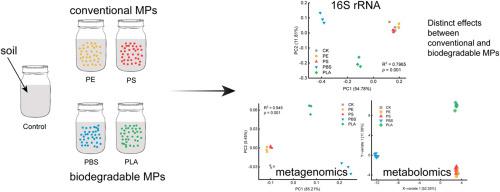Journal of Hazardous Materials ( IF 12.2 ) Pub Date : 2021-09-26 , DOI: 10.1016/j.jhazmat.2021.127282 Yuanze Sun 1 , Chongxue Duan 1 , Na Cao 1 , Changfeng Ding 2 , Yi Huang 3 , Jie Wang 1

|
Environmental concerns with liberal petroleum-based plastic use have led to demand for sustainable biodegradable alternatives. However, the inadequate end-of-life treatment of plastics may emit microplastics, either conventional or biodegradable, to the terrestrial environment. It is essential to evaluate the possible effects of conventional and biodegradable microplastics on the composition and function of soil microbial communities. Therefore, we conducted a soil microcosm experiment with polyethylene (PE), polystyrene (PS), polylactide (PLA), or polybutylene succinate (PBS) microplastics. The soil microbiome and metabolome were evaluated via 16S rRNA gene sequencing, metagenomics, and untargeted metabolomics. We reported that the presence of conventional or biodegradable microplastics can significantly alter soil microbial community composition. Compared to the control soils, the microbiome in PBS and PLA amended soils exhibited higher potential for uptake of exogenous carbohydrates and amino acids, but a reduced capacity for related metabolic function, potentially due to catabolite repression. No differences in soil metabolome can be observed between conventional microplastic treatments and the control. The potential reason may be that the functional diversity was unaffected by PE and PS microplastics, while the biodegradable particles promoted the soil microbial multifunctionality. Our findings systematically shed light on the influence of conventional and biodegradable microplastics on soil microorganisms, facilitating microplastic regulation.
中文翻译:

可生物降解的和传统的微塑料在土壤中表现出不同的微生物组、功能和代谢组变化
对自由使用石油基塑料的环境问题导致了对可持续生物降解替代品的需求。然而,塑料的报废处理不充分可能会向陆地环境排放传统的或可生物降解的微塑料。评估常规和可生物降解的微塑料对土壤微生物群落的组成和功能的可能影响至关重要。因此,我们使用聚乙烯 (PE)、聚苯乙烯 (PS)、聚丙交酯 (PLA) 或聚丁二酸丁二醇酯 (PBS) 微塑料进行了土壤微观世界实验。通过 16S rRNA 基因测序、宏基因组学和非靶向代谢组学评估土壤微生物组和代谢组。我们报道了常规或可生物降解的微塑料的存在可以显着改变土壤微生物群落组成。与对照土壤相比,PBS 和 PLA 改良土壤中的微生物组表现出更高的外源碳水化合物和氨基酸吸收潜力,但相关代谢功能的能力降低,这可能是由于分解代谢物的抑制。在传统的微塑料处理和对照之间,没有观察到土壤代谢组的差异。潜在的原因可能是功能多样性不受PE和PS微塑料的影响,而可生物降解的颗粒促进了土壤微生物的多功能性。我们的研究结果系统地揭示了传统和可生物降解的微塑料对土壤微生物的影响,促进了微塑料的调节。PBS 和 PLA 改良土壤中的微生物组表现出更高的外源碳水化合物和氨基酸吸收潜力,但相关代谢功能的能力降低,这可能是由于分解代谢物的抑制。在传统的微塑料处理和对照之间,没有观察到土壤代谢组的差异。潜在的原因可能是功能多样性不受PE和PS微塑料的影响,而可生物降解的颗粒促进了土壤微生物的多功能性。我们的研究结果系统地揭示了传统和可生物降解的微塑料对土壤微生物的影响,促进了微塑料的调节。PBS 和 PLA 改良土壤中的微生物组表现出更高的外源碳水化合物和氨基酸吸收潜力,但相关代谢功能的能力降低,这可能是由于分解代谢物的抑制。在传统的微塑料处理和对照之间,没有观察到土壤代谢组的差异。潜在的原因可能是功能多样性不受PE和PS微塑料的影响,而可生物降解的颗粒促进了土壤微生物的多功能性。我们的研究结果系统地揭示了传统和可生物降解的微塑料对土壤微生物的影响,促进了微塑料的调节。在传统的微塑料处理和对照之间,没有观察到土壤代谢组的差异。潜在的原因可能是功能多样性不受PE和PS微塑料的影响,而可生物降解的颗粒促进了土壤微生物的多功能性。我们的研究结果系统地揭示了传统和可生物降解的微塑料对土壤微生物的影响,促进了微塑料的调节。在传统的微塑料处理和对照之间,没有观察到土壤代谢组的差异。潜在的原因可能是功能多样性不受PE和PS微塑料的影响,而可生物降解的颗粒促进了土壤微生物的多功能性。我们的研究结果系统地揭示了传统和可生物降解的微塑料对土壤微生物的影响,促进了微塑料的调节。











































 京公网安备 11010802027423号
京公网安备 11010802027423号